Monthly Archive: September 2013
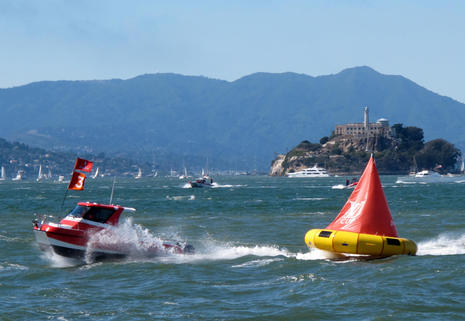 “Pretty cool…ESPN says one of the greatest upsets in sports history!” my brother-in-law emailed me last night, and he’s a guy who knows who pitched World Series games decades ago, and how well, but bupkis about the America’s Cup. Yes indeed, AC34 was incredibly unpredictable, and exciting, but I’ll argue that the winners all along were the teams who made the race management, umpiring, and broadcasting so innovative and so effective…
“Pretty cool…ESPN says one of the greatest upsets in sports history!” my brother-in-law emailed me last night, and he’s a guy who knows who pitched World Series games decades ago, and how well, but bupkis about the America’s Cup. Yes indeed, AC34 was incredibly unpredictable, and exciting, but I’ll argue that the winners all along were the teams who made the race management, umpiring, and broadcasting so innovative and so effective…
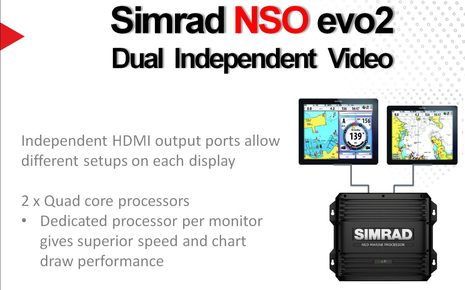 While Simrad may the last of the Big Four to introduce a high-performance multi-touch glass bridge system, it seems like they’ve added at least one significant twist to the concept. The new NSO evo2 black box contains two independent main processors which can drive two independent displays. The brochure claims that this architecture gives you “the freedom to view and control your onboard systems more easily while making every dual station installation or larger networked system simple and much more cost effective.” It’s a claim that I tentatively buy…
While Simrad may the last of the Big Four to introduce a high-performance multi-touch glass bridge system, it seems like they’ve added at least one significant twist to the concept. The new NSO evo2 black box contains two independent main processors which can drive two independent displays. The brochure claims that this architecture gives you “the freedom to view and control your onboard systems more easily while making every dual station installation or larger networked system simple and much more cost effective.” It’s a claim that I tentatively buy…
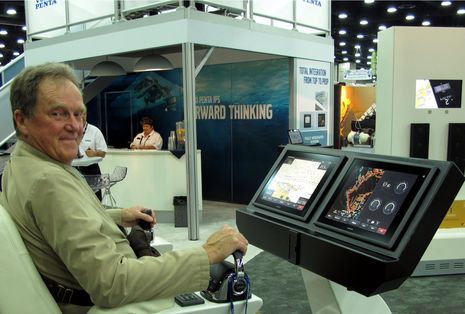 I just spent five full days at IBEX 2013 — as press guy, Innovation Awards judge, and NMEA seminar presenter — and I’m heading home with LOTS to write about. I’ll start with the deep integration Garmin and Volvo Penta put into the handsome Glass Cockpit system I was checking out above, and how smartly Raymarine has responded to this market-share threat. In my view it’s happy story about how competition and technology are making boating better…
I just spent five full days at IBEX 2013 — as press guy, Innovation Awards judge, and NMEA seminar presenter — and I’m heading home with LOTS to write about. I’ll start with the deep integration Garmin and Volvo Penta put into the handsome Glass Cockpit system I was checking out above, and how smartly Raymarine has responded to this market-share threat. In my view it’s happy story about how competition and technology are making boating better…
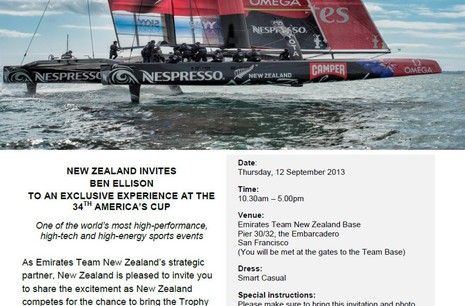 Best ticket ever? I’m so excited about getting slightly behind the Americas Cup 34 scene — and out on San Francisco Bay for races 6 and 7! — that I’m dreaming up things might go wrong. Could there be too much wind to race? In race 4 both boats averaged 31 knots — with bursts to 45 — in winds that averaged 19 with peak gusts at 23. Obviously things can really wrong when a catamaran is going that fast while delicately balanced on relatively tiny lifting foils. Or might Oracle Team USA find some way to delay further as crew and/or boat changes are hotly rumored?…
Best ticket ever? I’m so excited about getting slightly behind the Americas Cup 34 scene — and out on San Francisco Bay for races 6 and 7! — that I’m dreaming up things might go wrong. Could there be too much wind to race? In race 4 both boats averaged 31 knots — with bursts to 45 — in winds that averaged 19 with peak gusts at 23. Obviously things can really wrong when a catamaran is going that fast while delicately balanced on relatively tiny lifting foils. Or might Oracle Team USA find some way to delay further as crew and/or boat changes are hotly rumored?…
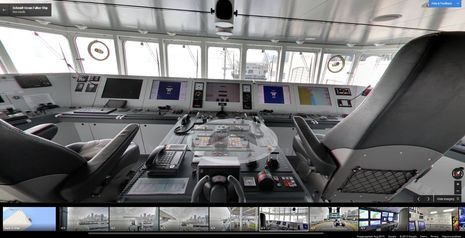 I was blown away, partially due to the timing. Just after writing about how apps can make fascinating historical cartogrphy easily accessible, I learned about a fascinating advance in 21st century mapping. I’d guess that most every Panbo reader has marveled at the seamless panoramic photography found in Google Street Maps; well, now it’s possible to use very similar technology to tour inside a ship, and the vessel Google chose for the first demonstration is a corker…
I was blown away, partially due to the timing. Just after writing about how apps can make fascinating historical cartogrphy easily accessible, I learned about a fascinating advance in 21st century mapping. I’d guess that most every Panbo reader has marveled at the seamless panoramic photography found in Google Street Maps; well, now it’s possible to use very similar technology to tour inside a ship, and the vessel Google chose for the first demonstration is a corker…
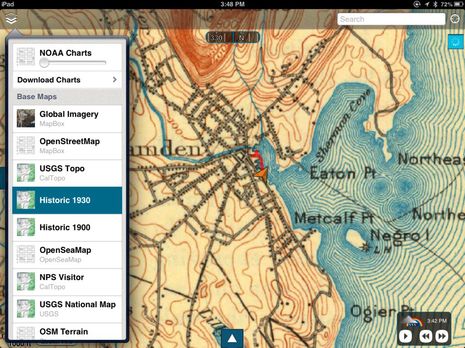 I was testing the new marine navigation app Skipper when I realized that historic topos were among the many “base maps” it can display along with regular NOAA raster charts. Skipper has some interesting features (to be covered soon), but I’ve been waiting a long time for this historic angle. Haven’t marine electronics and software become so powerful that they can help us with more than just the ‘work’ of operating a boat? As in my hopeful 2005 comment that “one day PC/plotter memory will be so abundant that historical charts will be included in navigation packages just for the fun of it!” Of course I didn’t realize then that tablet computers with wireless broadband Internet connections would come along, and aren’t they dandy for accessing the ever growing cloud of cartography?
I was testing the new marine navigation app Skipper when I realized that historic topos were among the many “base maps” it can display along with regular NOAA raster charts. Skipper has some interesting features (to be covered soon), but I’ve been waiting a long time for this historic angle. Haven’t marine electronics and software become so powerful that they can help us with more than just the ‘work’ of operating a boat? As in my hopeful 2005 comment that “one day PC/plotter memory will be so abundant that historical charts will be included in navigation packages just for the fun of it!” Of course I didn’t realize then that tablet computers with wireless broadband Internet connections would come along, and aren’t they dandy for accessing the ever growing cloud of cartography?
 “Pretty cool…ESPN says one of the greatest upsets in sports history!” my brother-in-law emailed me last night, and he’s a guy who knows who pitched World Series games decades ago, and how well, but bupkis about the America’s Cup. Yes indeed, AC34 was incredibly unpredictable, and exciting, but I’ll argue that the winners all along were the teams who made the race management, umpiring, and broadcasting so innovative and so effective…
“Pretty cool…ESPN says one of the greatest upsets in sports history!” my brother-in-law emailed me last night, and he’s a guy who knows who pitched World Series games decades ago, and how well, but bupkis about the America’s Cup. Yes indeed, AC34 was incredibly unpredictable, and exciting, but I’ll argue that the winners all along were the teams who made the race management, umpiring, and broadcasting so innovative and so effective…













